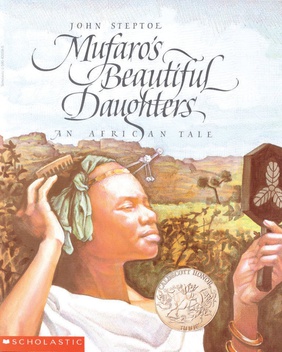Mufaro's Beautiful Daughters facts for kids
Quick facts for kids  |
|
| Author | John Steptoe |
|---|---|
| Illustrator | John Steptoe |
| Country | United States |
| Genre | Picture Book, Folktale |
| Publisher | Scholastic (1989) |
|
Publication date
|
1987 |
| Awards | Caldecott Honor Book |
Mufaro’s Beautiful Daughters is a popular children's picture book written and illustrated by John Steptoe. It was first published in 1987. This book is famous for its beautiful pictures and has won many awards. It is often used in schools to teach children about kindness and good choices.
What the Story is About
The story is about a kind man named Mufaro who lives with his two daughters, Nyasha and Manyara. The sisters are very different. Nyasha is known for her kindness, and everyone in the village likes her. Manyara, on the other hand, is often grumpy and mean to her sister when their father isn't looking.
One day, they hear exciting news: the Great King is looking for a wife! He wants to find a woman who is worthy of becoming his queen. Mufaro decides to send both of his daughters to the royal city.
Manyara starts her journey first. Along the way, she meets a hungry child, but she refuses to share any food. She also meets an old woman who offers helpful advice about some strange, laughing trees. But Manyara doesn't listen and rushes past them.
When Nyasha begins her journey, she acts differently. She kindly shares her food with the hungry boy. She also listens carefully to the old woman's advice.
When Nyasha and her father arrive in the city, they find Manyara very scared. Manyara begs them not to go into the king's room. She says there is a giant monster inside that told her about her bad deeds and threatened to eat her. Manyara is afraid it will hurt Nyasha too.
However, when Nyasha enters the king's chambers, she sees a harmless garden snake. This is the same snake she had met while gardening earlier. The snake then reveals a big secret: he is actually the king! He explains that he changed his shape during their journey. He did this to test the sisters' personalities and see how kind they truly were.
The king chooses to marry Nyasha because of her kindness and beauty, making her the new queen. Manyara, who was unkind, becomes Nyasha's servant.
Where the Story Came From
John Steptoe got the idea for Mufaro’s Beautiful Daughters from an old folktale. This tale was called Kaffir Folk-lore and was published by G.M. Theal in 1895.
Steptoe's drawings in the book show what he learned when he studied an ancient city in Zimbabwe. The pictures of the flowers and trees in the book are exact copies of those that grew in that old city long ago.
Main Characters
- Mufaro (moo-FAR-oh): His name means “happy man” in Shona, which is a language spoken in Zimbabwe. He is the father of Nyasha and Manyara. He has some power in his village.
- Nyasha (née-AH-sha): Her name means “mercy” in Shona. She is one of Mufaro's daughters. She is kind and becomes the queen at the end of the story.
- Manyara (mahn-YAR-ah): Her name means “ashamed” in Shona. She is Mufaro's other daughter. She becomes a servant at the end of the story. She is often mean to her sister, animals, and other villagers.
- Nyoka (née-YO-kah): Her name means “snake” in Shona. This character is actually the king, but we don't know that until the end. The king changed into a snake to secretly watch the village women. He wanted to find out which one would be a good wife.
Awards and Recognition
- The Caldecott Medal (1988): This special award is given every year to celebrate the best picture books.
- Coretta Scott King Award for Illustrators (1988): This award is given each year to an African American illustrator. It celebrates their work that shows "appreciation of African American culture and universal human values."

